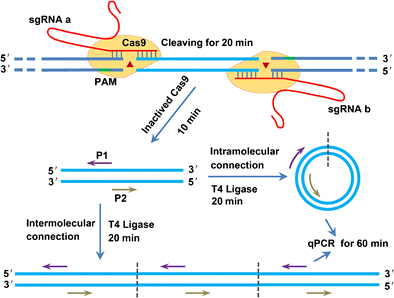Analytical and Bioanalytical Chemistry ( IF 3.8 ) Pub Date : 2018-03-15 , DOI: 10.1007/s00216-018-0873-5 Beibei Zhang 1 , Qiao Wang 1 , Xinhui Xu 1 , Qiang Xia 1 , Feifei Long 2 , Weiwei Li 3 , Yingchun Shui 3 , Xinyi Xia 3 , Jinke Wang 1
This study develops a new method for detecting target DNA based on Cas9 nuclease, which was named as CARP, representing CRISPR- or Cas9/sgRNAs-associated reverse PCR. This technique detects target DNA in three steps: (1) cleaving the detected DNA sample with Cas9 in complex with a pair of sgRNAs specific to target DNA; (2) ligating the cleaved DNA with DNA ligase; (3) amplifying target DNA with PCR. In the ligation step, the Cas9-cut target DNA was ligated into intramolecular circular or intermolecular concatenated linear DNA. In the PCR step, the ligated DNA was amplified with a pair of reverse primers. The technique was verified by detecting HPV16 and HPV18 L1 genes in nine different human papillomavirus (HPV) subtypes. The technique also detected the L1 and E6–E7 genes of two high-risk HPVs, HPV16 and HPV18, in the genomic DNA of two HPV-positive cervical carcinoma cells (HeLa and SiHa), in which no L1 and E6–E7 genes were detected in the HPV-negative cervical carcinoma cell, C-33a. By performing these proof-of-concept experiments, this study provides a new CRISPR-based DNA detection and typing method. Especially, the CARP method developed by this study is ready for the clinical HPV detection, which was supported by the final clinical sample detection.

CRISPR-associated reverse PCR (CARP) can be used to detect and type target DNA in a simple three-step procedure, cutting, ligation, and amplification.
中文翻译:

使用新型 Cas9/sgRNA 相关反向 PCR (CARP) 技术检测目标 DNA
本研究开发了一种基于Cas9核酸酶检测靶DNA的新方法,命名为CARP,代表CRISPR-或Cas9/sgRNAs相关反向PCR。该技术分三个步骤检测目标DNA:(1)用Cas9与一对目标DNA特异性的sgRNA复合物切割检测到的DNA样本; (2)用DNA连接酶连接切割后的DNA; (3)用PCR扩增目的DNA。在连接步骤中,将 Cas9 切割的目标 DNA 连接到分子内环状或分子间串联线性 DNA 中。在 PCR 步骤中,用一对反向引物扩增连接的 DNA。该技术通过检测九种不同人乳头瘤病毒 (HPV) 亚型中的 HPV16 和 HPV18 L1 基因得到验证。该技术还在两种 HPV 阳性宫颈癌细胞(HeLa 和 SiHa)的基因组 DNA 中检测到了两种高危 HPV(HPV16 和 HPV18)的 L1 和 E6-E7 基因,其中没有 L1 和 E6-E7 基因。在 HPV 阴性宫颈癌细胞 C-33a 中检测到。通过进行这些概念验证实验,本研究提供了一种新的基于 CRISPR 的 DNA 检测和分型方法。特别是本研究开发的CARP方法已经为临床HPV检测做好了准备,并得到了最终临床样本检测的支持。
在新窗口中打开图像

CRISPR 相关反向 PCR (CARP) 可用于通过简单的三步程序(切割、连接和扩增)来检测和分型目标 DNA。









































 京公网安备 11010802027423号
京公网安备 11010802027423号